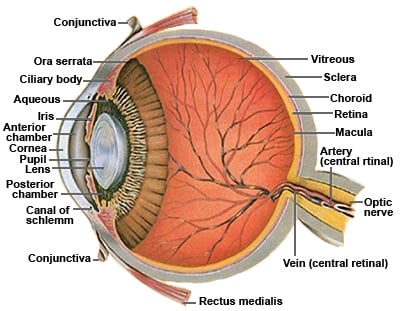1
Question
Describe the structure of human eye.
Open in App
Solution
The human eye has been called the most complex organ in the body. It is responsible for vision, color differentiation and maintaining the biological clock of the human body. The eye structure can be broadly classified as external structure and internal structure. The parts of the eye that are visible externally comprise of the external structure of the eye which includes sclera, conjuctiva, cornea, iris and pupil. The sclera is a tough and thick white sheath that protects the inner parts of the eye. Conjunctiva is a thin transparent membrane that is spread across the sclera and keeps the eyes moist and clear by secreting small amounts of mucus and tears. The cornea is the transparent layer of skin that is spread over the pupil and the iris. The job of the cornea is to refract the light that enters the eyes. Iris is a pigmented layer of tissue that makes up the colored portion of the eye. Its primary function is to control the size of the pupil, depending on the amount of light entering it. The pupil is the small opening located in the middle of the Iris and it allows light to come in.The internal structure of the eye includes retina, lens, aqueous humor, vitreous humor and optic nerve.The retina is the screen at the end of the eye, where all the images are formed. It is extremely sensitive to light because of the presence of Photoreceptors, which are photosensitive cells that detect dim and colored lights. A lens is a biconvex, transparent and adjustable structure that focuses light to the retina, hence forming images on it. Aqueous humor is a watery fluid that is present in the area between the lens and the cornea. It is responsible for the nourishment of both the lens and the cornea. Vitreous Humor is a transparent semi-solid, jelly-like substance that fills the interior of the eyes. Its role is that it maintains the shape of the eye and also causes refraction of light before it reaches the retina. Optic nerve located at the end of the eyes, behind the retina, the optic nerve is responsible for carrying all the nerve impulses from the photoreceptors to the brain, without which vision would not be possible.
The sclera is a tough and thick white sheath that protects the inner parts of the eye. Conjunctiva is a thin transparent membrane that is spread across the sclera and keeps the eyes moist and clear by secreting small amounts of mucus and tears. The cornea is the transparent layer of skin that is spread over the pupil and the iris. The job of the cornea is to refract the light that enters the eyes. Iris is a pigmented layer of tissue that makes up the colored portion of the eye. Its primary function is to control the size of the pupil, depending on the amount of light entering it. The pupil is the small opening located in the middle of the Iris and it allows light to come in.
The internal structure of the eye includes retina, lens, aqueous humor, vitreous humor and optic nerve.
The retina is the screen at the end of the eye, where all the images are formed. It is extremely sensitive to light because of the presence of Photoreceptors, which are photosensitive cells that detect dim and colored lights. A lens is a biconvex, transparent and adjustable structure that focuses light to the retina, hence forming images on it. Aqueous humor is a watery fluid that is present in the area between the lens and the cornea. It is responsible for the nourishment of both the lens and the cornea. Vitreous Humor is a transparent semi-solid, jelly-like substance that fills the interior of the eyes. Its role is that it maintains the shape of the eye and also causes refraction of light before it reaches the retina. Optic nerve located at the end of the eyes, behind the retina, the optic nerve is responsible for carrying all the nerve impulses from the photoreceptors to the brain, without which vision would not be possible.

Suggest Corrections
1
View More
Join BYJU'S Learning Program
Join BYJU'S Learning Program
